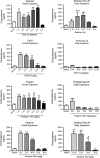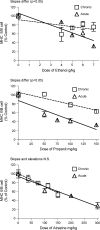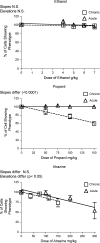Patterns of immunotoxicity associated with chronic as compared with acute exposure to chemical or physical stressors and their relevance with regard to the role of stress and with regard to immunotoxicity testing
- PMID: 19357072
- PMCID: PMC2683925
- DOI: 10.1093/toxsci/kfp073
Patterns of immunotoxicity associated with chronic as compared with acute exposure to chemical or physical stressors and their relevance with regard to the role of stress and with regard to immunotoxicity testing
Abstract
Previous studies have demonstrated that the stress response induced by some drugs and chemicals contributes in a predictable way to alteration of particular immunological parameters in mice. It has not been determined if mice can become tolerant or habituated with regard to the stress response and consequent immunological effects. Addressing this issue was the purpose of the present study. Mice were dosed daily for 28 days with atrazine, ethanol, propanil, or subjected to restraint, which are known to induce neuroendocrine stress responses and thereby to alter several immunological parameters. On day 29, a blood sample was taken and the spleen was removed for analysis of cellular phenotypes, differential cell counts (for blood), and natural killer (NK) cell activity. Corticosterone concentration at various times after dosing (or restraint) was also measured. Comparison of these results with results from previous studies with a single acute exposure revealed that the corticosterone response was almost completely absent in mice treated with ethanol, reduced in mice treated with restraint and propanil, and for atrazine the response was the same as noted for acute exposure. In most cases, the changes in immunological parameters were consistent with expectations based on these corticosterone responses. However, in a few cases (e.g., NK cell activity), it was clear that there were effects not mediated by stress. These results indicate that the nature of the stressor determines whether mice become tolerant with regard to the stress response and consequent immunological effects. This finding has practical implications for safety testing in mice.
Figures











Similar articles
-
Modeling and predicting immunological effects of chemical stressors: characterization of a quantitative biomarker for immunological changes caused by atrazine and ethanol.Toxicol Sci. 2003 Oct;75(2):343-54. doi: 10.1093/toxsci/kfg200. Epub 2003 Jul 25. Toxicol Sci. 2003. PMID: 12883079
-
Modeling and predicting selected immunological effects of a chemical stressor (3,4-dichloropropionanilide) using the area under the corticosterone concentration versus time curve.Toxicol Sci. 2000 Nov;58(1):77-87. doi: 10.1093/toxsci/58.1.77. Toxicol Sci. 2000. PMID: 11053543
-
Modeling and predicting stress-induced immunosuppression in mice using blood parameters.Toxicol Sci. 2005 Jan;83(1):101-13. doi: 10.1093/toxsci/kfi014. Epub 2004 Oct 27. Toxicol Sci. 2005. PMID: 15509669
-
The role of chemical-induced stress responses in immunosuppression: a review of quantitative associations and cause-effect relationships between chemical-induced stress responses and immunosuppression.J Toxicol Environ Health. 1993 Jun;39(2):163-92. doi: 10.1080/15287399309531744. J Toxicol Environ Health. 1993. PMID: 8501763 Review.
-
Safety and nutritional assessment of GM plants and derived food and feed: the role of animal feeding trials.Food Chem Toxicol. 2008 Mar;46 Suppl 1:S2-70. doi: 10.1016/j.fct.2008.02.008. Epub 2008 Feb 13. Food Chem Toxicol. 2008. PMID: 18328408 Review.
Cited by
-
Hydrogels Based on Proteins Cross-Linked with Carbonyl Derivatives of Polysaccharides, with Biomedical Applications.Int J Mol Sci. 2024 Jul 17;25(14):7839. doi: 10.3390/ijms25147839. Int J Mol Sci. 2024. PMID: 39063081 Free PMC article. Review.
-
The effect of atrazine administered by gavage or in diet on the LH surge and reproductive performance in intact female Sprague-Dawley and Long Evans rats.Birth Defects Res B Dev Reprod Toxicol. 2014 Jun;101(3):262-75. doi: 10.1002/bdrb.21109. Epub 2014 May 15. Birth Defects Res B Dev Reprod Toxicol. 2014. PMID: 24831581 Free PMC article.
-
Are the adverse effects of stressors on amphibians mediated by their effects on stress hormones?Oecologia. 2018 Feb;186(2):393-404. doi: 10.1007/s00442-017-4020-3. Epub 2017 Dec 8. Oecologia. 2018. PMID: 29222721
-
Contributions of nonhematopoietic cells and mediators to immune responses: implications for immunotoxicology.Toxicol Sci. 2015 Jun;145(2):214-32. doi: 10.1093/toxsci/kfv060. Toxicol Sci. 2015. PMID: 26008184 Free PMC article. Review.
-
The effects of gestational and chronic atrazine exposure on motor behaviors and striatal dopamine in male Sprague-Dawley rats.Toxicol Appl Pharmacol. 2015 Dec 1;289(2):185-92. doi: 10.1016/j.taap.2015.09.026. Epub 2015 Oct 9. Toxicol Appl Pharmacol. 2015. PMID: 26440580 Free PMC article.
References
-
- Anonymous. Health Effects Test Guidelines OPPTS 870.7800 Immunotoxicity, pp. 1–11. 1998 U.S. Environmental Protection Agency, Research Triangle Park, NC.
-
- Anonymous. NTP toxicology and carcinogenesis studies of 2,3,4,7,8-pentachlorodibenzofuran (PeCDF) (CAS No. 57117-31-4) in female Harlan Sprague-Dawley rats (gavage studies) Natl. Toxicol. Program Tech. Rep. Ser. 2006;525:1–198. - PubMed
-
- Brenner I, Shek PN, Zamecnik J, Shephard RJ. Stress hormones and the immunological responses to heat and exercise. Int. J. Sports Med. 1998;19:130–143. - PubMed
-
- Carson EJ, Pruett SB. Development and characterization of a binge drinking model in mice for evaluation of the immunological effects of ethanol. Alcohol Clin. Exp. Res. 1996;20:132–138. - PubMed
Publication types
MeSH terms
Substances
Grants and funding
LinkOut - more resources
Full Text Sources
Medical

